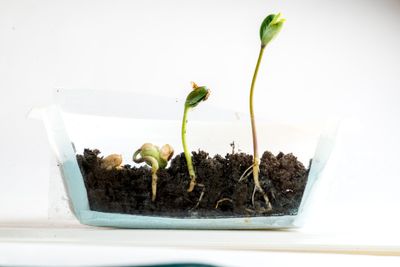What Causes Seed Germination?
The process of germination is when a seed comes out of dormancy, the time during which its metabolic activity is very slow. Germination begins with imbibition, a big word for taking in water. This is the major trigger to start the period of waking up from dormancy. As the seed takes in water, it gets bigger and produces enzymes. The enzymes are proteins that ramp up metabolic activity in the seed. They break down the endosperm, which is the seed’s store of food, to provide energy. The seed grows, and the radicle, or first stage of the root, emerges from the seed. Finally, the first little shoot comes out of the seed with cotyledons, the first two leaves, and photosynthesis can begin.
Germination Factors for Seeds
Specific seed germination requirements vary depending on the plant species. But they generally include water, air, temperature, and ultimately access to light. It helps to know the specific needs for the plants you’re working on to optimize germination. Fall too far outside the requirements and you’ll either get no seeds germinating, or only a portion.
Moisture. Of all the factors that determine seed germination, water is the first and most important. Without water it cannot happen and a seed will stay dormant. But too much water and a seed will rot. Soil should be moist but not soaked. Drainage is essential.
Oxygen. Seeds need access to oxygen, which is one reason soaked soil is counterproductive. It blocks this access. Soil should have a medium texture, not too packed or too light, in order to provide oxygen to germinating seeds.
Temperature. There is a wide variety of temperature requirements for seeds depending on species. For instance, your tomato seeds must be between 70 and 95 degrees Fahrenheit (21 and 35 C.) in order to germinate, but spinach seeds will only germinate between 45 and 75 degrees F. (7 and 24 C.).
Soil depth. Soil depth also varies, depending on seed size. A seed has a set amount of energy stored, and if it uses it all up before the cotyledons reach the surface and can access light, the seed will fail. Larger seeds need more depth to get rooted. Seed packets will provide the depth information.
Understanding seed germination requirements is important for growing plants successfully from seed. Know what your seeds need before you get started so you will get a greater percentage germinating and growing into seedlings.
